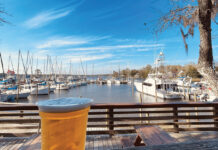By Matthew Vanderford
 I grew up in Nuw Churssee (that’s New Jersey for the uninitiated). For those who’ve never visited, it’s a unique place. And if you don’t know New Jersey, you probably won’t get New Jersey. But that’s the point – if you’re not from somewhere, you can never really know what it’s like to live there. That’s why you have to ask the locals when you travel where to get the best food, the out-of-the-way places to go that only they know about, and what the communities are like if you’re looking to move – I mean there’s only so much the internet and a travel agent can do!
I grew up in Nuw Churssee (that’s New Jersey for the uninitiated). For those who’ve never visited, it’s a unique place. And if you don’t know New Jersey, you probably won’t get New Jersey. But that’s the point – if you’re not from somewhere, you can never really know what it’s like to live there. That’s why you have to ask the locals when you travel where to get the best food, the out-of-the-way places to go that only they know about, and what the communities are like if you’re looking to move – I mean there’s only so much the internet and a travel agent can do!
Filing an insurance claim is very similar. In order to get what you’re looking for (your damaged property repaired or replaced), you need to know the people who deal with and repair properties on a day-to-day basis, day in, day out, week after week, year after year.
Every claim is different, and every loss is not the same, although they might share a lot of things in common. In the U.S., there are seven different climate zones, with those zones broken down into smaller sub sections creating an array of varying climate conditions which are then governed by local building ordinances describing to builders what types of materials they can use, how a property is to be built, etc. So, when you take all these factors: climate, materials used, and type of damage and then stick them in blender, do the hockey pokey and shake it all about, you can get very different results when loss occurs.
Humans have always been on the lookout for how to live in a world with climatic struggles to deal with no matter where we’ve lived. You wanna live in Iceland? Guess what – the Iceberg “Okjökull” just became “extinct.” You wanna live in the Philippines? You have to deal with monsoons. Japan maybe? Typhoons. Turkey? Earthquakes. Florida? Hurricanes, tornados and sink holes…oh my!
And because climate plays such a huge role in evaluating the risk of property exposure and claim payouts (damage to a property in Texas is not the same as damage to a property in Florida or in New Jersey). If you were to evaluate the effects of a storm damage to properties spread across the country, you’ll find the climate of the region directly impacts how much is needed to pay out valid claims, because payments made to repair damage need to reflect what it actually costs to repair the property in the region it was built. For example, homes built on the California coastline are not the same as homes built on the coastline of Florida. In fact, homes in Florida have some of the most stringent building codes in the nation due to the severity of climatic events. And because building codes and ordinances vary region to region (even in Florida), the structures will be comprised of many materials, some the same or similar, and others totally unique to the environment. And those differences make a huge difference in fair claim settlements.
Imagine yourself living in your home being slammed by a Category 5 hurricane. As it tears through your house leaving you in the wake of disaster, your insurance company sends out field adjusters from all over the country to handle the increase of claims as quickly as they can. Your field adjuster shows up, tells you they’re handling over 100 claims and will head back to Iowa, Texas or wherever they are from after all the dust settles.
Now, take a moment and ask yourself: How is a person from Iowa, Texas or somewhere else going to write a loss accurately for 100 claims if they don’t know the proper way to repair the materials used in the local construction area? And more importantly, how are you to expect anything different from the insurance company if you don’t know the rules of construction either?



























































